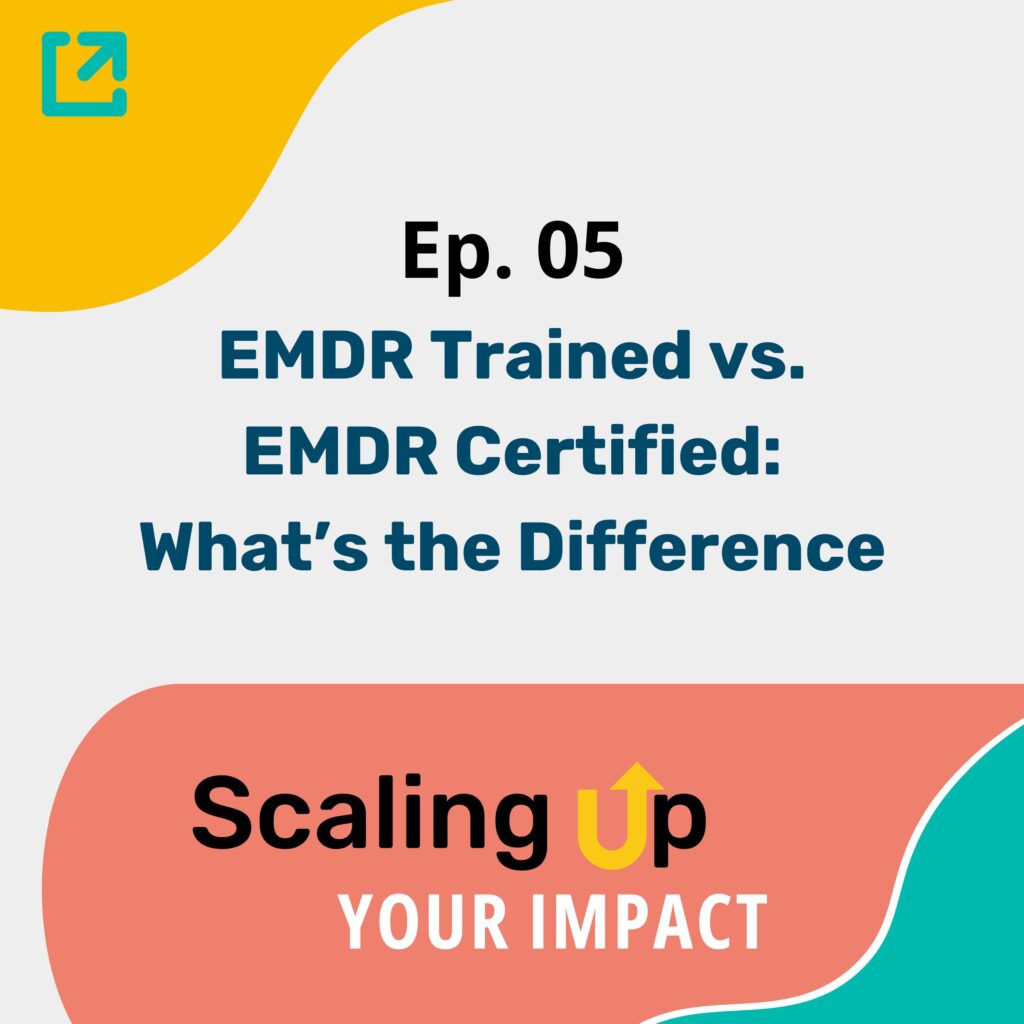Show Notes
Learn more about Scaling Up’s Certification Program here: scalingupemdr.com/certification-program
Get the full eligibility requirements and details about certification with EMDRIA at emdria.org
Transcript
Hi there, and welcome to Scaling Up Your Impact—the podcast for trauma-informed therapists who want to grow their skills, confidence, and reach—without burning out.
I’m Kelly Smyth-Dent, founder of Scaling Up, and today we’re answering a question that comes up all the time in our trainings, consultation groups, and online community:
What’s the difference between being EMDR-trained and being EMDR-certified?
If you’ve ever wondered this—or if you’re deciding whether to pursue EMDR Certification—this episode is for you.
Let’s start with what it means to be EMDR-trained.
When we say someone is “EMDR-trained,” it means they’ve completed an EMDRIA-approved EMDR Basic Training program.
Here’s what that typically includes:
- At least 20 hours of lecture
- At least 20 hours of practicum experience
- A minimum of 10 hours of consultation with an EMDRIA-approved consultant
- And completing all 8-phases of EMDR Therapy with at least 2 clients during the Basic Training period
This training is designed to give clinicians a foundational understanding of EMDR Therapy and how to begin applying it safely and ethically with clients.
Once you complete your Basic Training and meet all the attendance and participation requirements, you’re considered EMDR-trained.
This means:
✅ You’re eligible to provide EMDR Therapy in your clinical work
✅ You’ve learned the standard 8-phase EMDR protocol
✅ You’ve practiced with real memories in a supervised environment
However, at this stage, you’re not yet considered “certified” by EMDRIA. You’ve got the core tools—but like with many specialized therapies, ongoing development is strongly encouraged.
So what does EMDR Certification mean?
Certification is a formal recognition from EMDRIA that you’ve gone above and beyond the Basic Training requirements and demonstrated a higher level of skill and experience with EMDR Therapy.
Here’s what’s typically required for EMDR Certification:
- Completion of an EMDRIA-approved Basic Training (which we just talked about)
- Completion of advanced EMDR trainings totaling 12 EMDRIA CEUs
- At least 20 additional hours of consultation beyond your Basic Training consultation
- A minimum of two years of professional clinical experience
- Documentation showing you’ve conducted at least 50 EMDR therapy sessions with at least 25 different clients
- Letters of recommendation from two EMDRIA-approved consultants who can speak to your EMDR skills and ethical practice
- And yes—there’s an application process and a fee.
Certification shows that you’re not only using EMDR in your practice—but you’ve taken intentional steps to refine your clinical judgment, your application of the protocol, and your ability to adapt EMDR to meet client needs. It’s a professional milestone that many therapists use to demonstrate their commitment to high standards of trauma care.
So… does certification matter?
The short answer is: It depends on your goals.
For some clinicians, being EMDR-trained and using the protocol regularly with clients is enough for their setting and population. They may even take some advanced trainings and seek sporadic consultation, but they don’t want or need what Certification can offer.
But here are a few reasons you might want to pursue Certification:
✅ Credibility: Some clients, agencies, or referral sources specifically seek out “certified” EMDR therapists. Certification signals advanced training and experience.
✅ Confidence: Those additional consultation hours provide a space to troubleshoot tough cases, deepen your understanding of complex presentations, and strengthen your clinical decision-making.
✅ Professional Growth: Certification often opens the door to future roles—like becoming an EMDR Consultant or trainer down the line.
✅ Ethics and Competence: EMDRIA emphasizes that Certification ensures therapists have the experience and support needed to deliver EMDR safely—especially for complex trauma, dissociation, and co-occurring issues.
And for your clients? Having a Certified EMDR Therapist means their clinician has had more supervision, more case experience, and more direct mentorship in delivering EMDR safely and effectively.
Whether you’re newly EMDR-trained or considering the next step toward Certification, remember this: Both milestones matter.
Completing EMDR Basic Training is a huge achievement. It opens the door to transformational work with your clients.
Pursuing Certification is about building on that foundation. It’s for therapists who want more depth, more skill, and more confidence—especially when working with complex trauma cases.
At Scaling Up, we offer a fully online EMDR Certification Program designed to guide you through the process—from start to finish. Our program includes:
- 10 hours of group consultation hours + a consultant matching quiz to help you find your ideal consultant for the required 10 individual consultation hours
- On-demand clinical training videos to fulfill the required 12 EMDRIA CEUs
- Expert support from EMDRIA-approved consultants
- A step-by-step Certification Checklist and other resources to help you stay on track
Whether you’re just starting to think about Certification or you’re already partway there, our program is built to meet you where you are—and help you get across the finish line with confidence.
You can learn more and sign up at scalingupemdr.com/certification-program.
If you want more information on the difference between training and certification, EMDRIA has a great resource at emdria.org.
These links can be found in the show notes for easy access!
Thanks so much for listening today. Wherever you are on your EMDR path—trained, certified, or somewhere in between—you’re doing important work.
We’re here to support you every step of the way.
Until next time—keep scaling up your impact.



